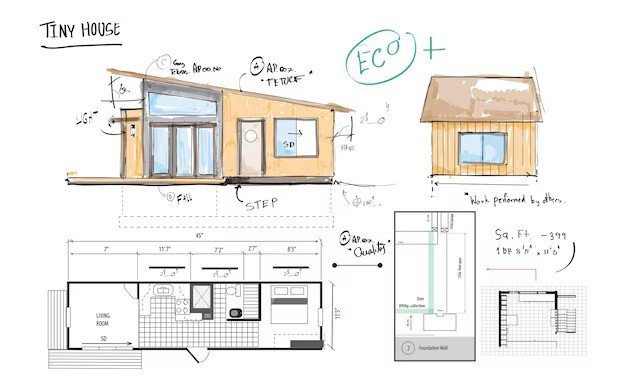Floor Plans for Tiny Homes (2025) – Best Flooring Ideas & Trends
Discover floor plans for tiny homes with the best 2025 flooring trends. Learn how colors, patterns, and eco-friendly choices make small spaces feel bigger.

Designing a tiny home is both exciting and challenging. With limited square footage, every design choice matters—including the floor beneath your feet. While floor plans for tiny homes determine how functional and livable a space feels, flooring materials, colors, and patterns significantly influence the perception of size, comfort, and style.
In 2025, flooring is doing more than just covering surfaces—it’s helping homeowners make their small spaces feel open, sustainable, and connected. Let’s explore how the right flooring complements tiny home layouts and the latest design trends.
Why Flooring Matters in Floor Plans for Tiny Homes

Image source: pinterest.com
In compact layouts, flooring decisions carry extra weight. The color, texture, and layout of floors can:
-
Visually expand or shrink a space.
-
Improve natural light reflection.
-
Enhance functionality and comfort.
-
Support the flow between connected areas.
For example, a tiny home floor plan with an open kitchen and living room feels much larger when one continuous flooring material is used throughout. Meanwhile, narrow hallways can be transformed with clever plank direction or a patterned tile.
2025 Tiny Home Design Trends You Should Know

Image source: pinterest.com
Recent surveys and design reports highlight the following key trends shaping tiny home floor plans this year:
-
Eco-conscious materials: Reclaimed wood, bamboo, and cork are increasingly chosen for sustainability and indoor air quality.
-
Biophilic design: Natural textures and finishes connect homeowners with nature, making small spaces feel calmer.
-
Flexible layouts: Open plans with sliding dividers or multi-use furniture maximize every inch.
-
Smart integration: Underfloor heating, climate controls, and lighting systems free up space while adding efficiency.
-
Community living: Many tiny home communities now plan shared green areas, walkways, and common lounges, making layout choices even more important.
Flooring Colours: Light vs. Dark in Small Homes

Image source: pinterest.com
-
Lighter shades (oak, ash, whitewashed wood) reflect natural light, brightening small rooms and making them feel larger. They’re especially useful in windowless bathrooms or narrow hallways.
-
Dark flooring can still work in tiny home layouts when paired with light walls and furnishings. The result is a dramatic, cocoon-like feel without overwhelming the room.
Patterns and Plank Direction

Image source: pinterest.com
The way flooring is laid impacts spatial perception:
-
Lengthwise planks across narrow rooms create an illusion of width.
-
Diagonal or herringbone layouts in corridors prevent a tunnel-like feel and add visual movement.
-
Cabochon tile patterns (octagonal tiles with square insets) are making a comeback in 2025, perfect for small entryways or kitchens where a stylish focal point is needed.
Materials That Work Best in Tiny Home Floor Plans

Image source: pinterest.com
Different rooms demand different flooring properties, but in small layouts, consistency is key. Popular 2025 flooring options include:
-
Luxury vinyl or laminate: Affordable, durable, and available in a wide range of styles. Both mimic natural wood and stone beautifully while being easier to maintain—making them perfect for compact, high-traffic areas.
-
Engineered wood: Gives the warmth of hardwood while being more stable in humid conditions.
-
Cork & bamboo: Eco-friendly, renewable, and insulating—both sound and thermal.
-
Linoleum: 100% biodegradable, hypoallergenic, and dust-resistant, making it an underrated but smart choice for small homes.
Creating Consistency Across Spaces

Image source: pinterest.com
Tiny homes feel larger when flooring flows continuously from room to room. For example:
-
Living + kitchen + hallway: One seamless wood or vinyl floor visually enlarges the layout.
-
Bathrooms: Waterproof vinyl or pale stone can be used while matching tones to adjoining areas.
-
Rugs: Define zones (living, dining, sleeping) without breaking up the open feel.
Room-by-Room Flooring Inspiration
| Room | Flooring Idea (2025 Trends) |
| Living Room | Wide, pale oak planks with a matte finish; pairs with natural fabrics and slimline furniture. |
| Kitchen | Luxury vinyl in wood or stone finishes; seamless into dining areas to avoid visual chop. |
| Bathroom | Waterproof stone-look tiles, cabochon mosaics, or eco-linoleum for spa-like practicality. |
| Bedroom | Warm bamboo or cork flooring layered with a lightweight rug for comfort and soundproofing. |
| Hallways | Planks laid lengthwise with a vintage or minimalist runner rug for guided flow. |
Accessories and Lighting to Maximize Impact

Image source: pinterest.com
Flooring rarely works alone. To get the most out of your tiny home floor plan:
-
Use neutral walls to complement pale floors.
-
Add mirrors and reflective finishes to amplify light.
-
Choose glass or acrylic furniture to keep more of the flooring visible.
-
Install underfloor heating to eliminate bulky radiators.
Eco-Friendly Flooring: The Sustainable Choice

Image source: pinterest.com
Sustainability matters more than ever. Studies confirm that bio-based flooring options—such as cork, bamboo, and reclaimed wood—have a significantly lower carbon footprint than synthetic choices.
-
Bamboo grows back in 5–7 years, making it highly renewable.
-
Cork is harvested from bark without harming trees, and it insulates sound and heat.
-
Reclaimed wood reduces waste and adds timeless character.
-
Linoleum is biodegradable and naturally antimicrobial.
By integrating these into your tiny home floor plan, you balance beauty, function, and eco-responsibility.
Smart Upgrades for 2025

Image source: pinterest.com
-
Underfloor heating: Efficient and space-saving.
-
Smart thermostats & lighting: Automate comfort while reducing energy use.
-
Zoning with texture: Subtle rugs or patterned inlays can separate areas without walls.
Final Thoughts
The best floor plans for tiny homes combine smart layouts with flooring choices that visually expand space and enhance comfort. Lighter tones, continuous flow, eco-friendly materials, and clever use of patterns can transform even the smallest areas into inviting, functional, and stylish spaces.
In 2025, design is about flexibility, sustainability, and connection. With thoughtful flooring aligned to your layout, your tiny home can feel far more spacious and liveable than its square footage suggests.
FAQs About Floor Plans for Tiny Homes and Flooring
1. What type of flooring is best for tiny homes?
The best flooring for tiny homes is light-colored wood, vinyl, or laminate. These materials make small spaces look bigger and are easy to clean.
2. Does light flooring really make a room look larger?
Yes. Light floors reflect more light, so the room feels brighter and more open. This is very helpful in small rooms with little sunlight.
3. Can I use dark flooring in a tiny home?
Yes, you can. Dark floors look stylish, but you should balance them with light walls and furniture so the room does not feel too small.
4. What flooring is eco-friendly for small homes?
Bamboo, cork, reclaimed wood, and linoleum are eco-friendly. They are natural, safe, and good for the environment.
5. Should I use the same flooring in all rooms of a tiny home?
Yes, using the same flooring in most rooms makes the space feel larger and more connected. You can add rugs to separate areas if needed.
6. Is vinyl flooring good for kitchens and bathrooms in tiny homes?
Yes. Luxury vinyl flooring is waterproof, durable, and easy to clean. It is perfect for kitchens, bathrooms, and other busy areas.

















